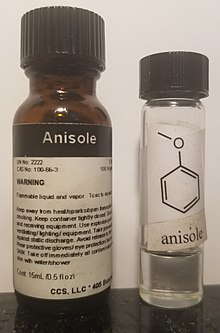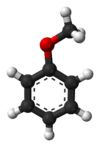Anisole
Anisole, or methoxybenzene, is an organic compound with the formula CH3OC6H5. It is a colorless liquid with a smell reminiscent of anise seed, and in fact many of its derivatives are found in natural and artificial fragrances. The compound is mainly made synthetically and is a precursor to other synthetic compounds. It is an ether.
| |||
 | |||
| Names | |||
|---|---|---|---|
| Preferred IUPAC name
Anisole[1] | |||
| Systematic IUPAC name
Methoxybenzene[1] | |||
| Other names
Methyl phenyl ether[1] Phenoxymethane | |||
| Identifiers | |||
3D model (JSmol) |
|||
| 506892 | |||
| ChEBI | |||
| ChEMBL | |||
| ChemSpider | |||
| ECHA InfoCard | 100.002.615 | ||
| EC Number |
| ||
| 2964 | |||
| KEGG | |||
PubChem CID |
|||
| RTECS number |
| ||
| UNII | |||
| UN number | 2222 | ||
CompTox Dashboard (EPA) |
|||
| |||
| |||
| Properties | |||
| C7H8O | |||
| Molar mass | 108.140 g·mol−1 | ||
| Appearance | Colorless liquid | ||
| Density | 0.995 g/cm3 | ||
| Melting point | −37 °C (−35 °F; 236 K) | ||
| Boiling point | 154 °C (309 °F; 427 K) | ||
| Solubility | Insoluble | ||
| -72.79·10−6 cm3/mol | |||
| Hazards | |||
| GHS pictograms |   | ||
| GHS Signal word | Warning | ||
GHS hazard statements |
H226, H315, H319 | ||
| P210, P233, P240, P241, P242, P243, P264, P280, P302+352, P303+361+353, P305+351+338, P321, P332+313, P337+313, P362, P370+378, P403+235, P501 | |||
| NFPA 704 (fire diamond) | |||
| Lethal dose or concentration (LD, LC): | |||
LD50 (median dose) |
3700 mg/kg (rat, oral) | ||
Except where otherwise noted, data are given for materials in their standard state (at 25 °C [77 °F], 100 kPa). | |||
| Infobox references | |||
It can be prepared by the Williamson ether synthesis; sodium phenoxide is reacted with a methyl halide to yield anisole.
Reactivity
Anisole undergoes electrophilic aromatic substitution reaction more quickly than does benzene, which in turn reacts more quickly than nitrobenzene. The methoxy group is an ortho/para directing group, which means that electrophilic substitution preferentially occurs at these three sites. The enhanced nucleophilicity of anisole vs. benzene reflects the influence of the methoxy group, which renders the ring more electron-rich. The methoxy group strongly affects the pi cloud of the ring as a mesomeric electron donor, more so than as an inductive electron withdrawing group despite the electronegativity of the oxygen.
Illustrative of its nucleophilicity, anisole reacts with acetic anhydride to give 4-methoxyacetophenone:
- CH3OC6H5 + (CH3CO)2O → CH3OC6H4C(O)CH3 + CH3CO2H
Unlike most acetophenones, but reflecting the influence of the methoxy group, methoxyacetophenone undergoes a second acetylation. Many related reactions have been demonstrated. For example, P4S10 converts anisole to Lawesson's reagent, [(CH3OC6H4)PS2]2.
The ether linkage is highly stable, but the methyl group can be removed with hydroiodic acid:
- CH3OC6H5 + HI → HOC6H5 + CH3I
Preparation
Anisole is prepared by methylation of sodium phenoxide with dimethyl sulfate or methyl chloride:[2][3]
- 2 C6H5O−Na+ + (CH3O)2SO2 → 2 C6H5OCH3 + Na2SO4
Applications
Anisole is a precursor to perfumes, insect pheromones, and pharmaceuticals.[3] For example, synthetic anethole is prepared from anisole.
Safety
Anisole is relatively nontoxic with an LD50 of 3700 mg/kg in rats.[4] Its main hazard is its flammability.[4]
See also
- Anethole
- Bromoanisole
- Butylated hydroxyanisole
- Ether
- Ethyl phenyl ether
- Phenol
- 2,4,6-Trichloroanisole (cork taint)
References
- Nomenclature of Organic Chemistry : IUPAC Recommendations and Preferred Names 2013 (Blue Book). Cambridge: The Royal Society of Chemistry. 2014. pp. 702–703. doi:10.1039/9781849733069-00648. ISBN 978-0-85404-182-4.
Anisole, C6H5-O-CH3, is the only name in the class of ethers which is retained both as a preferred IUPAC name and for use in general nomenclature. For preferred IUPAC names, no substitution is allowed; for general nomenclature substitution is allowed on the ring and on the side chain under certain conditions (see P-34.1.1.4).
- G. S. Hiers and F. D. Hager (1941). "Anisole". Organic Syntheses.; Collective Volume, 1, p. 58
- Helmut Fiege, Heinz-Werner Voges, Toshikazu Hamamoto, Sumio Umemura, Tadao Iwata, Hisaya Miki, Yasuhiro Fujita, Hans-Josef Buysch, Dorothea Garbe, Wilfried Paulus “Phenol Derivatives“ in Ullmann's Encyclopedia of Industrial Chemistry, 2002, Wiley-VCH, Weinheim. doi:10.1002/14356007.a19_313
- MSDS Archived July 1, 2010, at the Wayback Machine
External links
- International Chemical Safety Card 1014
- Pherobase pheromone database entry


